PART I. How We Got Here: A Brief History
Now in its third year, the College of Computing is on an upward trajectory. Student enrollment is up appreciably and other key indicators confirm that the upward trend will continue. In this three-part series, we take a close look at how we got here, what our college looks like today, and what we're working to accomplish as we look to the future.
Part I | Part II | Part III | Timeline
The Early Days

In 1973, computing at Michigan Tech was done on large mainframe computers weighing many hundreds, if not thousands, of pounds. Students prepared their class programming assignments on noisy keypunch machines, turned in their decks at batch stations, and waited eagerly for minutes or hours to get back the listing containing the results of their runs—from a machine with less computing power than the average smartphone today. Michigan Tech introduced the Computer Science bachelor's program the same year, which was offered through the Mathematics department, but CS and Math majors had separate classifications and the units had separate budgets.
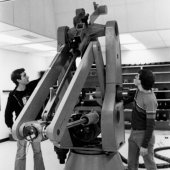
The Applied Computing department traces its roots to the 1960s. The Electrical Engineering Technology program was started in 1967, and in 1969 the Department of Applied Technology was established, which would become the School of Technology (SoT) in 1975. The School of Technology offered two-year degree programs in forest technology, electrical engineering technology, civil engineering technology and electro-mechanical technology, diesel mechanics, and nursing. In 1994, the SoT began offering four-year programs in engineering technology, and eventually all two-year programs at Michigan Tech were phased out.
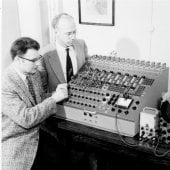
The first BS degree in Computer Science was awarded in 1974. Graduates had earned 29 credits of CS courses, 34 of mathematics courses, and 27 technical elective credits. Also in 1974, John Lowther was hired as the first Computer Science faculty member.
A New Department
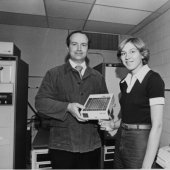
In 1977, the Mathematics department, part of the College of Sciences and Arts, became the Department of Mathematical and Computer Sciences (MACS). The same year, a Hewlett-Packard 9640A was acquired for dedicated use by the CS department students and faculty. The microprogrammable processor with writable control store was primarily used to teach operating systems and computer architecture courses. Additional HP-funded upgrades followed.
The Master of Science in Computer Science was added in 1981, and the first degree was awarded in 1982.
In 1984, there were approximately 450 students enrolled in the Computer Science major and, following an external review, it was determined that CS should split into a separate department in the College of Science and Arts. The Department of Computer Science was officially launched in fall 1987, representing another important milestone in the evolution of computing at Michigan Tech.
The PhD in Computational Science and Engineering, which was Michigan Tech's first computing-focused doctoral program, was created in 1994. The interdisciplinary program remains today with faculty from several different departments, including Applied Computing, Geological and Mining Engineering and Sciences, and Mathematical Sciences.
The 2000s
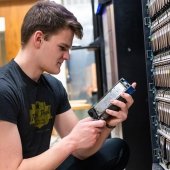
During the 2000s, there was campus-wide growth in computing programs. The BS in Computer Engineering, in which students take a nearly equal number of courses from electrical engineering (EE) and computer science, was added in the fall of 2000. This degree program was offered by the Department of Electrical Engineering, in the College of Engineering, which subsequently changed its name to Electrical and Computer Engineering (ECE).
The stand-alone PhD in Computer Science was established in 2001 and the BS in Software Engineering was created in 2003.
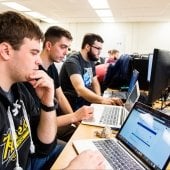
The BS in Computer Network and System Administration (CNSA) was established in 2003 in the School of Technology. The program emphasizes computing infrastructure, information technology, and system administration, and as such is distinct from Computer Science, which emphasizes foundations of computing, algorithms, and software.
Later, recognizing the growing importance of computing and informatics in the sciences, BS programs were created in both Bioinformatics and Cheminformatics.
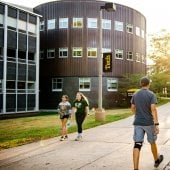
Groundbreaking for the Ann and Kanwal Rekhi Hall occurred May 9, 2003. By this time, the CS department had expanded beyond their original offices in Fisher Hall with faculty and graduate students housed in Fisher Hall, the Dow Building, and the Chem Sci building. The Computer Science department moved into Rekhi Hall in January 2005, with the new building's official dedication on April 29, 2005.
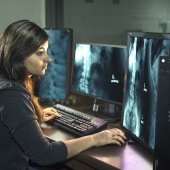
The University approved a Strategic Faculty Hiring Initiative (SFHI) focused on computing, called Computational Discovery and Innovation, in Spring 2008. The following academic year (2008-09) new faculty were recruited in core computing disciplines and across campus to enhance computational research and teaching. The SFHI was a collaborative effort between CS and Electrical and Computer Engineering (ECE) and included plans to further develop educational opportunities for both majors and non-majors in computing and to increase interdisciplinary computational research.
In 2011, a major gift from ECE alumnus Paul Williams made possible the creation of the Williams Center for Computer Systems Research, a 10,000 sq. ft. facility in space formerly occupied by the Seaman Mineral Museum on the 5th floor of the EERC. The home of the Institute of Computing and Cybersystems, the space is administered by the ECE Department and devoted in large part to fostering research collaborations between ECE and CS.
Initially growing out of the CNSA program in the School of Technology, the MS in Medical Informatics was launched in 2012. The name was changed to the MS in Health Informatics in 2019. The program focuses on the acquisition, storage, retrieval and use of information in healthcare, and is the first graduate program at Michigan Tech to offer all of its courses online.
In 2015, the MS in Data Science was added. It was moved to the Department of Computer Science in 2021.
Reformulating Computing at Michigan Tech
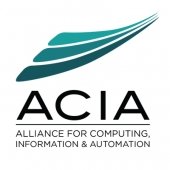
In 2012, the organization of Michigan Tech's activities within the nexus of electrical and computer technologies was examined, leading to recommendations for closer cooperation and discussion among units across campus, cross-departmental curriculum committees, and the planting of a seed for a College of Computing at Michigan Tech.
In 2014, the Alliance for Computing, Information, and Automation (ACIA) was established in a collaboration among the Department of Computer Science, the Department of Electrical and Computer Engineering, and the School of Technology undergraduate programs in Computer Network and Systems Administration and Electrical Engineering Technology.
The ACIA made plans for an interdisciplinary research institute, and in 2015 the Institute of Computing and Cybersystems (ICC) was launched. The ICC currently administers a nearly $10 million portfolio of grant awards and contracts, and generates annual research expenditures approaching $3 million. The ACIA also led the establishment of an interdisciplinary M.S. in Cybersecurity in 2015, which is now hosted in the College of Computing.

In 2015, the MS in Data Science was established by the Electrical and Computing Engineering department. In 2019, it was moved to the Department of Computer Science.

In October 2017, the Office of the Provost established the Computing and Information Sciences (CIS) Working Group in follow up to a Michigan Tech campus-wide retreat on computing and information sciences in August 2017.
The ad hoc committee of Michigan Tech faculty members carried out a year-long investigation of the state of computing education and research at Michigan Tech. In their final report, the working group recommended the formation of a new administrative unit, headed by a dean reporting to the provost, with a focus on computing and information sciences. The name of the unit was not yet determined.
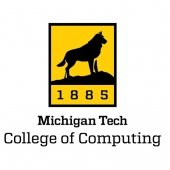
In fall 2018, Michigan Tech embarked on "Tech Forward," a series of campus conversations to identify initiatives with the potential to propel the University forward. Championed by President Rick Koubek, Tech Forward initiatives aim to position Michigan Tech as an internationally recognized academic thought leader, and to foster an agile Michigan Tech that influences and adapts to a world in which our graduates face a magnitude of change that previous generations could hardly have imagined.
Among the nine Tech Forward initiatives is Data Revolution and Sensing (DRS). The deliberations of the DRS task force in the spring of 2019 led to the creation of the College of Computing as a distinct academic unit, one that unites new and existing academic disciplines in a responsive and adaptive structure.
A New College on Campus

The College of Computing was approved by the Michigan Tech Board of Trustees in April 2019. The new unit was led by Dr. Adrienne Minerick until March 2021, when current dean Dr. Dennis Livesay joined the College. Dr. Minerick planted and nurtured the beginnings of several college initiatives that are bearing fruit today.
The new academic unit combines the faculty of the Department of Computer Science, formerly part of the College of Sciences and Arts, and the faculty in the Computer Network and System Administration, Electrical Engineering Technology, and Health Informatics programs, formerly part of the School of Technology.
The Department of Computer Science retains its name and its identity, and as of 2020 the programs from the School of
Technology are now combined in the Department of Applied Computing, the newest academic department on campus.
The College administers degree programs and supports teaching and research in fields including
computer science, software engineering, cybersecurity, computer network and system administration, electrical engineering technology, data science, and interdisciplinary convergence programs such as mechatronics and computational science and engineering. The College also leads a campus-wide initiative to incorporate computational thinking
and basic coding skills in all Michigan Tech degree programs.
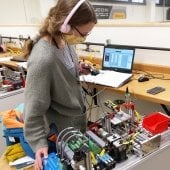
In fall 2019, the MS in Mechatronics was established. In fall 2020, the BS in Mechatronics was added. The programs are part of the Department of Applied Computing.
In the second installment of this three-part blog series, "The Computing Revolution is Accelerating at Michigan Tech" we'll highlight what our college looks like today. In the third and final installment, we'll fill you in on our future goals and the initiatives we're pursuing to make them happen.
Historical photographs courtesy of the Michigan Tech Archives.